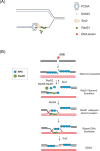Multifunctional roles of Saccharomyces cerevisiae Srs2 protein in replication, recombination and repair
- PMID: 28011904
- PMCID: PMC5399913
- DOI: 10.1093/femsyr/fow111
Multifunctional roles of Saccharomyces cerevisiae Srs2 protein in replication, recombination and repair
Abstract
The Saccharomyces cerevisiae Srs2 DNA helicase has important roles in DNA replication, recombination and repair. In replication, Srs2 aids in repair of gaps by repair synthesis by preventing gaps from being used to initiate recombination. This is considered to be an anti-recombination role. In recombination, Srs2 plays both prorecombination and anti-recombination roles to promote the synthesis-dependent strand annealing recombination pathway and to inhibit gaps from initiating homologous recombination. In repair, the Srs2 helicase actively promotes gap repair through an interaction with the Exo1 nuclease to enlarge a gap for repair and to prevent Rad51 protein from accumulating on single-stranded DNA. Finally, Srs2 helicase can unwind hairpin-forming repeat sequences to promote replication and prevent repeat instability. The Srs2 activities can be controlled by phosphorylation, SUMO modification and interaction with key partners at DNA damage or lesions sites, which include PCNA and Rad51. These interactions can also limit DNA polymerase function during recombinational repair independent of the Srs2 translocase or helicase activity, further highlighting the importance of the Srs2 protein in regulating recombination. Here we review the myriad roles of Srs2 that have been documented in genome maintenance and distinguish between the translocase, helicase and additional functions of the Srs2 protein.
Keywords: DNA helicase; DNA repair, recombination; Srs2, toxic recombination; anti-recombinase; translocase.
© FEMS 2016. All rights reserved. For permissions, please e-mail: journals.permissions@oup.com.
Figures





Similar articles
-
Cdk1 targets Srs2 to complete synthesis-dependent strand annealing and to promote recombinational repair.PLoS Genet. 2010 Feb 26;6(2):e1000858. doi: 10.1371/journal.pgen.1000858. PLoS Genet. 2010. PMID: 20195513 Free PMC article.
-
The Main Role of Srs2 in DNA Repair Depends on Its Helicase Activity, Rather than on Its Interactions with PCNA or Rad51.mBio. 2018 Jul 17;9(4):e01192-18. doi: 10.1128/mBio.01192-18. mBio. 2018. PMID: 30018112 Free PMC article.
-
DNA Damage Tolerance Pathway Choice Through Uls1 Modulation of Srs2 SUMOylation in Saccharomyces cerevisiae.Genetics. 2017 May;206(1):513-525. doi: 10.1534/genetics.116.196568. Epub 2017 Mar 24. Genetics. 2017. PMID: 28341648 Free PMC article.
-
Multifaceted role of the Saccharomyces cerevisiae Srs2 helicase in homologous recombination regulation.Biochem Soc Trans. 2005 Dec;33(Pt 6):1447-50. doi: 10.1042/BST0331447. Biochem Soc Trans. 2005. PMID: 16246143 Review.
-
How yeast cells deal with stalled replication forks.Curr Genet. 2020 Oct;66(5):911-915. doi: 10.1007/s00294-020-01082-y. Epub 2020 May 11. Curr Genet. 2020. PMID: 32394094 Review.
Cited by
-
Meiosis-specific recombinase Dmc1 is a potent inhibitor of the Srs2 antirecombinase.Proc Natl Acad Sci U S A. 2018 Oct 23;115(43):E10041-E10048. doi: 10.1073/pnas.1810457115. Epub 2018 Oct 9. Proc Natl Acad Sci U S A. 2018. PMID: 30301803 Free PMC article.
-
Helicase Mechanisms During Homologous Recombination in Saccharomyces cerevisiae.Annu Rev Biophys. 2019 May 6;48:255-273. doi: 10.1146/annurev-biophys-052118-115418. Epub 2019 Mar 11. Annu Rev Biophys. 2019. PMID: 30857400 Free PMC article. Review.
-
Alternative Lengthening of Telomeres in Yeast: Old Questions and New Approaches.Biomolecules. 2024 Jan 16;14(1):113. doi: 10.3390/biom14010113. Biomolecules. 2024. PMID: 38254712 Free PMC article. Review.
-
The biochemistry of early meiotic recombination intermediates.Cell Cycle. 2018;17(23):2520-2530. doi: 10.1080/15384101.2018.1553355. Epub 2018 Dec 10. Cell Cycle. 2018. PMID: 30482074 Free PMC article. Review.
-
Post-Translational Modifications of PCNA: Guiding for the Best DNA Damage Tolerance Choice.J Fungi (Basel). 2022 Jun 10;8(6):621. doi: 10.3390/jof8060621. J Fungi (Basel). 2022. PMID: 35736104 Free PMC article. Review.
References
Publication types
MeSH terms
Substances
Grants and funding
LinkOut - more resources
Full Text Sources
Other Literature Sources
Molecular Biology Databases
Research Materials
Miscellaneous

